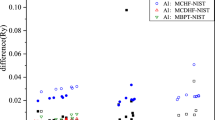Abstract
Intensities of carbon radio recombination lines are analytically described as function of line number, temperature and medium concentration. Accounting for the process of dielectronic recombination the balance equations for highly excited carbon populations as b n-factors are solved by the diffusional approximation. To determine medium temperature and density with the experimental amplification coefficients the system of boundary condition equations is formulated as \(\frac{{\partial ^2 b_n }}{{\partial n^2 }}\left| {_{n = n1} = 0} \right.\). Analytically found in the range of temperatures T e = 25-100, 104 K the line amplification coefficients are compared with the numerical solutions. By the method of radio lines intensity ratio of carbon for the observations at frequencies 34.5–25 MHz the density magnitudes are calculated towards Cassiopeia A as function of temperature.
Similar content being viewed by others
References
Anantharamajah, K.R., Erickson, W.C. and Payne, H.E.: 1994, Astrophys. J. 430, 690.
Anantharamajah, K.R., Nimisha, G., Kantharia and Payne, H.E.: 1998, Astrophys. J. 506, 758.
Anantharamajah, K.R., Nimisha, G., Kantharia and Goss, W.M.: 1998, Astrophys. J. 504, 375.
Beigman, I.L.: 1987, Trud. Phys. Institute AS USSR 179, 160.
Beigman, I.L., Vainstein, L.A. and Sunyaev, R.A.: 1968, Uspeh. Fis. Nauk 95, 267 (Russian).
Brocklehurst, M. and Salem, M.: 1979, Astrophys. J. Suppl. Ser. 39, 633.
Davies, P.C.W. and Seaton, M.J.: 1969, J. Phys. B 2, 757.
Dupree, A.K.: 1969, Astrophys. J. 158, 491.
Dyson, J.E.: 1967a, Astrophys. J. Lett. 150, L45.
Dyson, J.E.: 1967b, Astron. J. 73, 511.
Ershov, A.A., et al.: 1984, Pis'ma v AZh 10, 833.
Gordon, M.A. and Walmsley, C.M.: 1990, Astrophys. J. 365, 606.
Konovalenko, A.A.: 1984, Pis-ma v AZh 10, 846.
Konovalenko, A.A.: 1990, 25 years of investigations, Kluwer, Dordrecht, 175.
Konovalenko, A.A. and Golynkin, A.A.: 1991, Sov. Astron. J. Lett. 17, 16.
Ponomarev, V.O. and Sorochenko, R.L.: 1992, Pis'ma v AZh 18, 541.
Rovenskaya, N.I.: 1992, Astrophys. Space Sci. 188, 89.
Rovenskaya, N.I.: 1999, Astrophys. Space Sci. 259, 1.
Seaton, M.J.: 1964, Mon. Not. R. Astron. Soc. 127, 177.
Shaver, P.A.: 1975, Pramana 5, 1.
Smirnov, G.T., Sorochenko, R.L. and Walmsley, C.M.: 1995, Astron. Astrophys. 300, 923.
Sobel'man, I.I.: 1963, Introduction in the atomic spectroscopy theory, Physmatgis, Moscow, 640.
Vainstein, L.A., Sobel'man, I.I. and Ukov, E.A.: 1979, Excitation of atoms and spectral line broadening, Nauka, Moscow, 284.
Walmsley, C.M. and Watson, W.D.: 1982, Astrophys. J. 260, 317.
Author information
Authors and Affiliations
Rights and permissions
About this article
Cite this article
Rovenskaya, N. Populations of Highly Excited Carbon Accounting for Dielectronic Recombination Process. Astrophysics and Space Science 281, 715–727 (2002). https://doi.org/10.1023/A:1016376407004
Issue Date:
DOI: https://doi.org/10.1023/A:1016376407004



